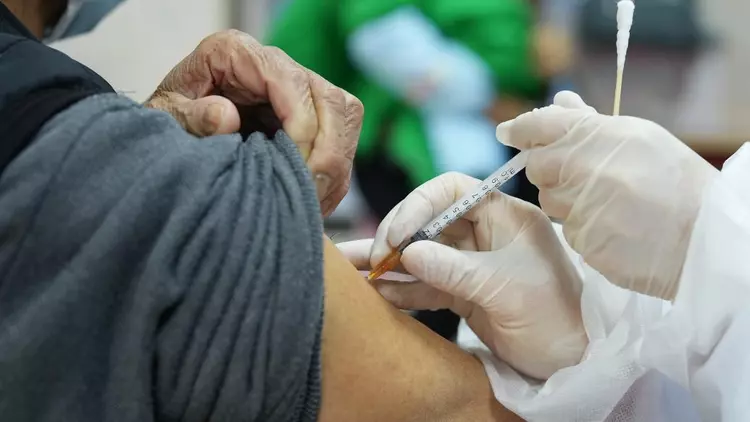
Temporary immunization protection for the Beijing population has been established, and the return of the Spring Festival to Beijing will not cause a major impact
The peak of the epidemic in Beijing has passed.
Today (January 31), Wang Quanyi, deputy director of the Beijing CDC, gave an interview to Xinjing News, in which he said that Beijing has established temporary population immunization protection and the risk of an epidemic in the near future is low, and older people over 80 years old can be vaccinated in time during this “window period”.
Next month, Beijing will carry out a population survey of serum antibody levels to comprehensively assess the situation of the new coronavirus infection.

File photo
Beijing’s outbreak is coming to an end, with cases in circulation
The Chinese New Year has passed and people are returning to Beijing. What is the situation of the epidemic in Beijing and will there be a rebound?
Wang Quanyi said that the epidemic in Beijing has passed its peak and entered its final stage, and is now in an epidemic state, with the main prevalent strains still being BF.7 and BA.5.2.
According to the sampling and monitoring data of influenza-like cases in Beijing, in the fourth week of 2023 (January 23-29), the number of influenza-like cases in the cumulative number of outpatient and emergency clinic visits monitored by medical institutions above the second level in Beijing decreased by 40.87% compared with the previous week, 84.53% compared with the same period last year, and 93.74% compared with the peak of this epidemic season; Beijing collected and tested a total of A total of 453 respiratory specimens were collected and tested in Beijing, of which 23 were positive for nucleic acid of the new coronavirus, with a positive rate of 5.08% (compared to 11.59% in the previous week).
After the peak has passed, the population has established temporary immune protection, and with some cross-protection between the current international epidemic virus and the strains circulating in Beijing this round, there is less risk of an epidemic occurring in the near future, at least for three months. With the end of the Chinese New Year, crowds are returning to Beijing, but in the context of the national peak having passed, there will be no major impact.
He reminded that the vaccination rate for the elderly over 80 years old in Beijing is low, and as a high-risk group for serious illness, the elderly should be vaccinated in a timely manner. It is still the epidemic season for respiratory infectious diseases, and the public should take daily precautions by paying attention to frequent hand washing, wearing masks in public places, and opening windows for daily ventilation.
Beijing to conduct population-based serum antibody level survey
As the epidemic comes to an end, the CDC will carry out a summative survey and research. Wang Quanyi said that a population-based serum antibody survey will be conducted in order to comprehensively assess the situation of new coronavirus infection in Beijing and to understand the serum antibody levels in the community. The study will provide a reference for future optimization of resource allocation and prevention and control of neo-crown.
The survey is planned to be completed from February to March 2023, and will adopt a multi-stage stratified random sampling method to select approximately 5,000 community populations from 16 jurisdictions and economic development zones in Beijing for questionnaire and serological specimen collection. The contents of the questionnaire included basic information about the survey respondents, nucleic acid and antigen testing, onset of consultation referrals, vaccination status and other information.
Wang Quanyi told the reporter that considering that the antibody level will also decline naturally over time, a dynamic assessment may be carried out in the future as needed.
Virus surveillance will be carried out in the local and inbound population during the “Category B” period
According to Beijing’s “Category B” program, Beijing will adopt a graded approach to social prevention and control. Based on multidimensional surveillance data to carry out qualitative analysis, and comprehensive consideration of the epidemic intensity, severity and the occupation of medical resources and other factors, the establishment of a perfect expert risk research and evaluation mechanism, timely epidemic warning, the risk of epidemic prevention and control recommendations.
Wang Quanyi introduced that risk assessment is the next key work to be carried out by the CDC. Based in Beijing, look at the world, from the source control, system identification analysis and assessment of risk, is still the main idea of work. From the specific approach, on the one hand, to monitor the virus mutation, on the other hand, to monitor the epidemic intensity.
The surveillance of virus mutation covers two major categories of people, inbound and indigenous, and the CDC department cooperates with multiple departments such as customs and medical institutions to perform nucleic acid testing and virus gene sequencing.
He used the example of inbound surveillance. Customs will conduct antigen and nucleic acid testing for people with fever and respiratory symptoms, and samples found to be positive for new crowns and with Ct values less than 32 will be sent to CDC for gene sequencing; for people who are in the incubation period at the time of entry, medical staff will ask about the past seven days of entry history when they seek medical attention, and if the samples are positive and meet the conditions for sequencing, they will also be sent to CDC. This data will help professionals keep track of virus mutation and importation.
Monitoring the epidemic intensity will be combined with Beijing’s existing influenza-like case surveillance system. Influenza-like cases are reported in Beijing hospitals above the first level, and 39 hospitals currently conduct pathogenic surveillance. Surveillance data from clinics are calculated by relevant models to invert the number of infections and epidemic intensity at the social level. Combined with dynamic community surveys, network surveys and other multi-channel data to corroborate each other, it is easy for CDC to provide epidemic warning and medical institutions to respond.
In addition, CDC will also conduct research surveillance, such as studying the evolution of the new coronavirus in different populations, and studying virus infection and evolution in animals.


Average Rating